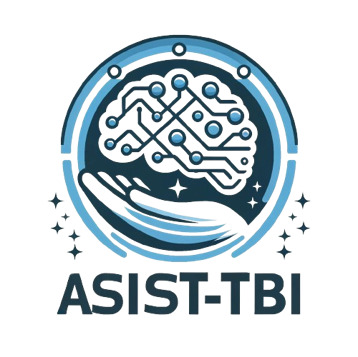Automated Surgical Intervention Support Tool for Traumatic Brain Injury (ASIST-TBI)


Model Development & Training

Incorporation of Artificial Intelligence into Clinical Workflow to Optimize Triage and Establish Early Warning Systems for Patients with Traumatic Brain Injury
Led by Dr. Christopher Witiw, this retrospective study proposes employing machine learning algorithms to analyze head CTs for traumatic brain injury (TBI) with intracranial hemorrhage (ICH) and predict which patients will require: (1) immediate neurosurgical intervention, (2) close observation due to a high risk of clinical or radiologic deterioration potentially leading to surgery, or (3) admission for observation without the need for surgical intervention.
Our team developed a vision transformer-based artificial intelligence (AI) model, the Automated Surgical Intervention Support Tool for Traumatic Brain Injury (ASIST-TBI), which is anticipated to help streamline the neurosurgical referral process by stratifying patients who require urgent consultation from those who can potentially be managed at the referring center. The model aims to support healthcare providers by identifying patients at risk of clinical or radiologic deterioration.
Beat Neurosurgeons & Live Local Deployment

Baseline assessment of ASIST-TBI (Automated Surgical Intervention Support Tool for Traumatic Brain Injury): comparing an artificial intelligence decision support system to clinicians.
This retrospective study, led by Dr. Christopher Witiw, aims to compare the performance of ASIST-TBI to that of clinicians (neurosurgeons and emergency physicians) in triaging patients with TBI. The study is guided by the following hypotheses:
1. Neurosurgeons, when blinded to clinical covariates and only evaluating head CTs, will perform similarly to the ASIST-TBI model.
2. Emergency physicians, when blinded to clinical covariates and only evaluating head CTs, will perform inferiorly to the ASIST-TBI model.
3. Neurosurgeons will perform the triaging task more accurately than the emergency physicians. There will be more inter-observer variability between emergency physicians.
4. ASIST-TBI will maintain its performance when evaluating head CT scans of patients from the emergency department.
Specific Aim 4: Assess and compare ASIST-TBI’s performance for all scans acquired at the St. Michael’s hospital during a 12-month period.Our team developed a vision transformer-based artificial intelligence (AI) model, the Automated Surgical Intervention Support Tool for Traumatic Brain Injury (ASIST-TBI), which is anticipated to help streamline the neurosurgical referral process by stratifying patients who require urgent consultation from those who can potentially be managed at the referring center. The model aims to support healthcare providers by identifying patients at risk of clinical or radiologic deterioration.
Externally Validated

External Validation of the Automated Surgical Intervention Support Tool for Traumatic Brain Injury (ASIST-TBI)
This retrospective study, led by Dr. Christopher Witiw, aims to externally validate the ASIST-TBI model using head CT scans from the CENTER-TBI prospective cohort study, a large, multi-national European project that collects clinical and imaging data from TBI patients across more than 20 countries.
This study will evaluate the following three hypotheses:
1. ASIST-TBI will demonstrate consistent test characteristics and clinical utility (sensitivity and specificity) on an external validation dataset.
2. Model performance will not be age- or sex-biased
3. Task shifting from prediction of surgical intervention to functional outcomes will be feasible through transfer learning.
Provincial Deployment

Provincial Pilot Deployment of the Automated Surgical Intervention Support Tool for Traumatic Brain Injury (ASIST-TBI)
This retrospective study, led by Dr. Christopher Witiw, aims to evaluate the feasibility of deploying ASIST-TBI across Ontario through a pilot study involving 10 initial hospitals. The model will be deployed silently, without altering existing clinical workflows. Head CT scans from brain-injured patients will be collected via the Emergency Neuro Imaging Transfer System (ENITS), which is currently used to transmit scans for neurosurgical consultations to tertiary centers. A copy of each scan will be routed to our research group’s secure server, where it will be analyzed by the ASIST-TBI model. Patient outcomes will be gathered in collaboration with CritiCall Ontario. The primary prediction task will be determining whether the patient requires transfer to a neurosurgical center.
We aim to test the following hypothesis:
ASIST-TBI will demonstrate consistent test characteristics and clinical utility (sensitivity and specificity) during pilot deployment.